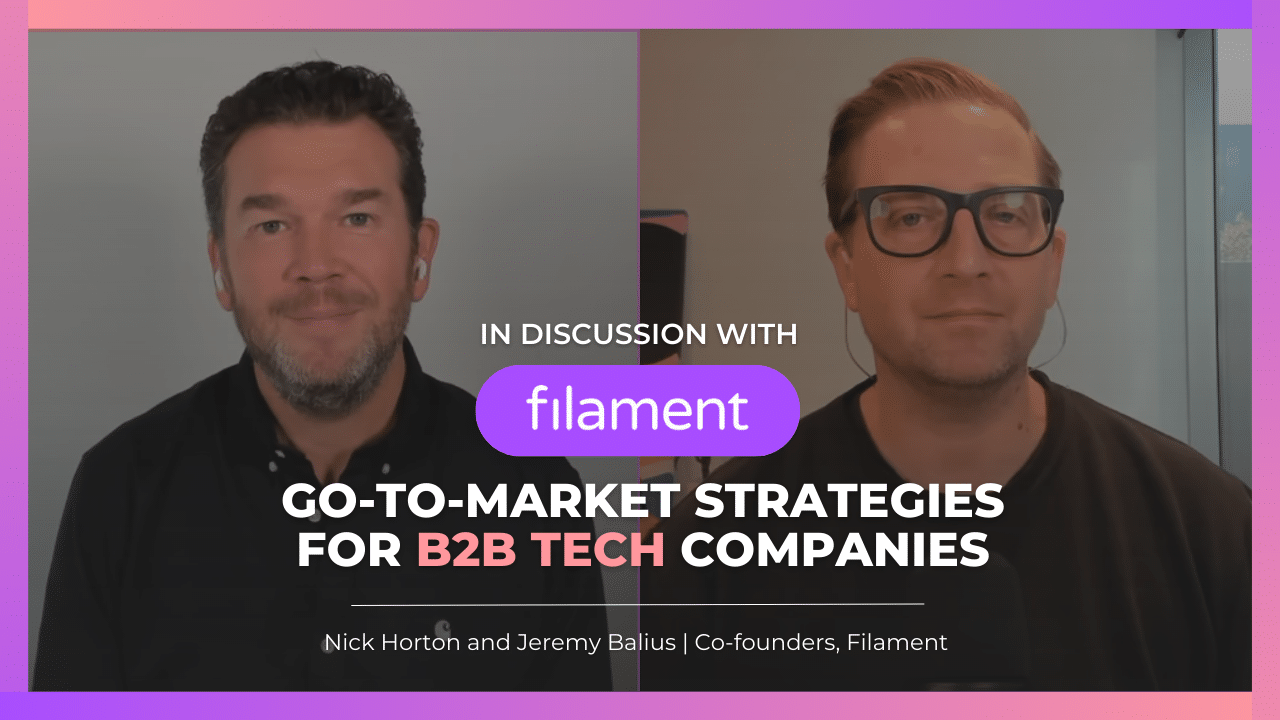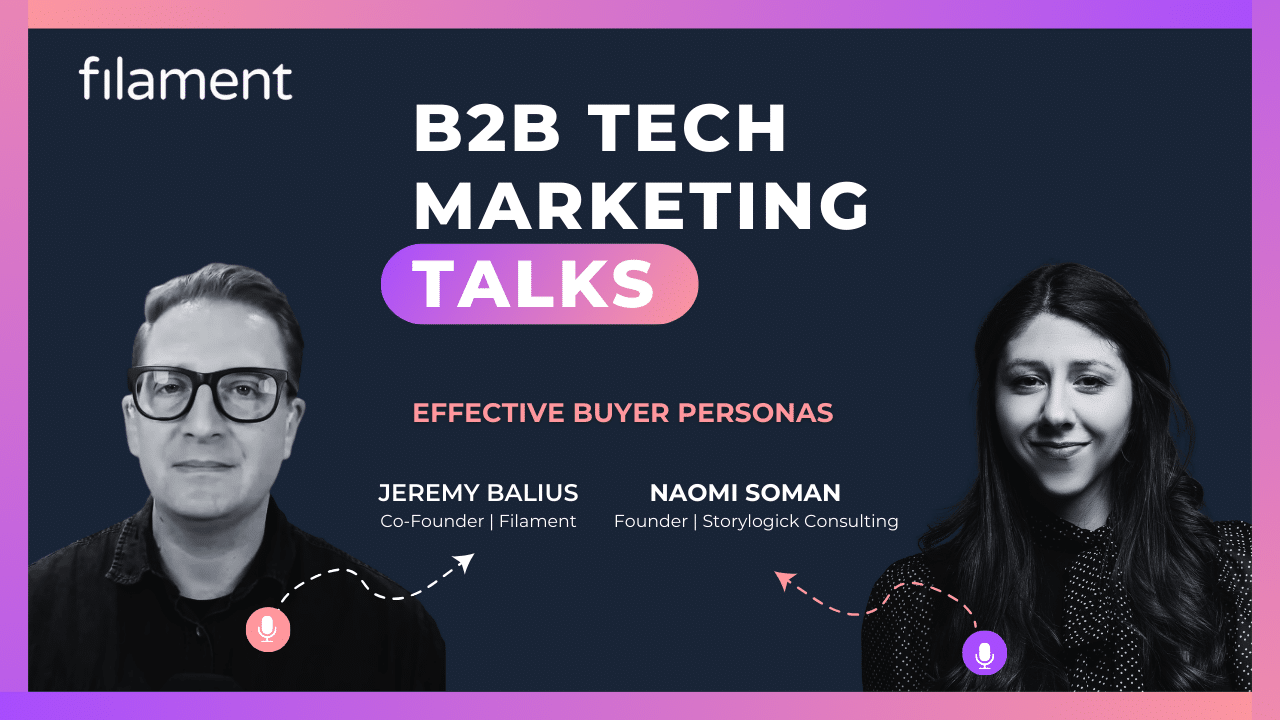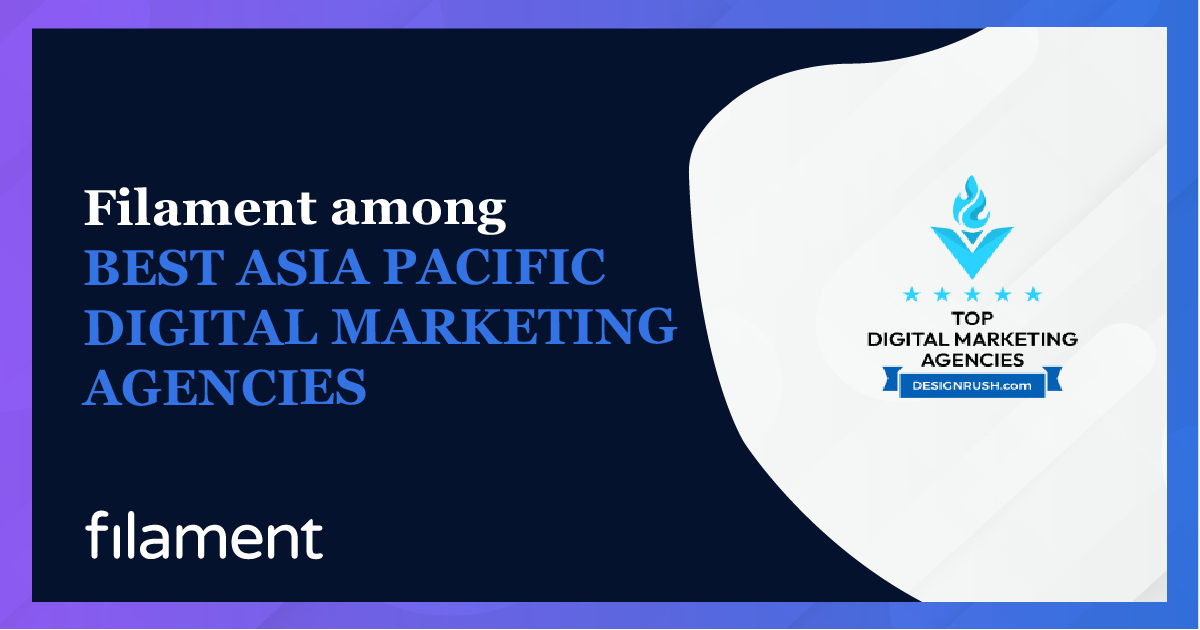Go-To-Market Strategies for B2B Tech – In Discussion
In conversation with Nick Horton and Jeremy Balius, discussing all things Go-to-Market for B2B tech companies.

Here are Filament founders Nick Horton and Jeremy Balius, discussing all things Go-to-Market for B2B tech companies.
Topics covered include:
- Common challenges and pitfalls Go-To-Market teams face
- Timeframes of Go-To-Market motions
- How to talk to non-marketing business leaders about demand generation
- The critical importance of a value proposition
- The challenge of expectations in B2B marketing
- Taking a multi-horizon approach to Go-To-Market motions
- And so much more!
A key takeaway phrase from this conversation is to “always be going to market” in your B2B technology business.
Click play to watch the discussion or read the transcript below.
Transcript of Nick & Jeremy's discussion on Go-To-Market Strategies for B2B Tech Companies
Jeremy: Hey, Nick, what are some of the common challenges that B2B tech companies are facing as they’re taking products and services to market?
Nick: Yeah. Hey, thanks Jeremy.
It’s a great question and something that we get often from our clients.
I think the first thing that we see quite often is that there’s a mismatch between what the local go-to-market team wants to do and what the overall organization is asking them to do.
We know in Southeast Asian markets, for instance, that Chinese New Year is two weeks where no one’s working. I’ve worked in businesses where we’ve launched products in Chinese New Year and it doesn’t work. Cause you are selling into a market that’s just not buying at that time.
And that’s a real common pitfall, actually getting that alignment. Another example was when I was working for a handset manufacturer in Europe. One of our clients one of our big telco clients in Europe. They had a very structured buying cycle. The key. Selling period at for them was in the lead up to Christmas.
So basically from the end of October through to the middle of December. So their whole process was about selecting the products that they wanted to launch in that timeframe, making sure that the marketing and go to market was lined up against that. And that process actually started in about February.
The, 10 months ahead of when the activity was actually gonna happen. And a lot of my job was actually working with our head office teams to help them understand that dynamic, help them understand that we will be extremely successful if we are able to deliver and our planning and our go-to market and our marketing lines up with.
The key buying windows effectively that our clients had. So solving that mismatch or finding a way through that mismatch is one of the key things that you can do to ensure success of your go-to-market launch. But also, it’s one of the failures that we see too often happening.
Jeremy: Yeah and I think the mismatch there is a really critical word, particularly when we are considering the messaging and the communication strategy being developed very late in the piece. Yep. W. What kind of timeframes do you see? Commonly as we are brought in to support businesses or what we see businesses do as they’re preparing or taking products to market whether the product or the service has already been developed.
And then they’re trying to develop messaging almost as the final phase in the final lead up.
Nick: Yeah. And look, I think this is a the, this timing challenge is something that all of our clients will be familiar with. We know in the B2C world you launched a new product, you put it on the supermarket shelves, it’s gonna start selling straight away.
But in the B2B world, we have to be building demand for the product with service way ahead of actually the sale taking place. So obviously, you know that timing depends. And so where we’re where we find the pressure really goes on is a new product for service comes to market. W we work with our client to make sure that there’s a good period of demand generation that we’re building up demand, that we’re really starting to position the product as a way to solve that key business challenge for for the prospective customer.
But does that constant pressure to. Give me leads straightaway. Give me appointments straightaway. Give me sales straightaway. And Being able to come in early, be involved in the planning process, being considered about the, when we expect results to happen, that there will need to be a period of demand generation.
It could be a month, it could be six months, depending on the product or service and depending on the sales cycle that we’re selling into, just. Making sure that’s really built into the into the planning process so that’s gonna really guarantee the success that we’re following a very thoughtful and planned out approach around the timing of the launch.
Jeremy: What you’re saying is no publishing a press release and sales flowing in the same day.
Nick: Yeah. Wouldn’t that be wonderful? The reality and, our experience tells us that it does take a little bit longer. We see a lot of business leaders who are running awesome tech businesses.
Jeremy: The, let’s say a layer down from what you were just describing previously, turnover is 50 to a hundred mil. They’ve got fantastic cloud computing services or security offerings. These businesses often only have a single marketer or a small team. They are launching a new service and are relying on a couple of individuals to take that to market and are expecting immediate outcomes.
How do we talk to these business leaders about demand in the first instance?
Nick: Yeah. Yeah. And that’s, a situation that we often find ourselves in.
By working with them as part of a team, we’re really able to identify, what is that go-to-market journey what is that buying journey for a client that they need to go through. And, typically it’ll be a client will or a prospect will, will understand that they have a business challenge.
They start looking for partners that can help solve that challenge. They start to eliminate Suppliers or vendors that for one of, for whatever reason, don’t provide a great challenge. Then they go into an evaluation phase and then they really start to gather information around, what’s it gonna be like to deploy?
What’s the pricing gonna be, what’s the support gonna be? All of those questions that you need to have ticked off before you before you buy. And then probably at that stage will be when the prospect actually wants to start talking to a salesperson. So sometimes we see a real pressure for as soon as someone fills in a form on a website as an example, or responds to a LinkedIn campaign.
The sales team wanna get on the phone with that person straight away, or they wanna send an appointment with that prospect straight away. And so it’s really helping as part of that combined team define, who does what. And the marketer’s role is to take all of those. People that are filled in a form and really nurture them so that when the sales team speaks to that prospect, they’re really in a position to, to buy and hammer out the deal or hammer out the terms of what they want to and the basis on which they want to engage.
That’s really a lot of the support that we provide for that. Solo marketer, if you like, is really helping define that framework. Looking at how the demand generation process feeds into a lead generation process, feeds into a sale and being very considerate about the role of the different communications within that process.
Jeremy: Let’s say I’m the Chief Revenue Officer of a infrastructure as a service provider. We’ve got all our kit sitting on VMware. We also hook in Cisco and Dell and a few other vendors.
We are launching a desktop as a service into market. Or some kind of virtual desktop service. Where do I start? I don’t feel like my database has prospects because I feel like I’ve been caning that with EDMs all along anyways. I don’t know how to get this message to market. We have a service page. We’ve got an inquiry form. My marketers are publishing content to social media. I’ve got a speaking engagement coming up at an event. What am I doing wrong?
Nick: Yeah. I guess the, oftentimes you’re probably not doing anything wrong. Your tactics are probably correct.
You probably know from previous product launches that going to events is a great way to speak to decision makers quickly. Having advertising campaigns or having direct email campaigns are a good way to keep a audience warmed up or start to build a demand within an audience.
If that message is not getting cut through, then I think probably what you need to be doing is looking more fundamentally at what your value proposition is. How do you match up what your or. What you’re selling or how you talk about what you’re selling with, what your clients are actually asking for.
And if you can go through an exercise and it doesn’t need to be, a long drawn out strategic consulting type engagement but go through the exercise of just. Reevaluating your value proposition or even maybe developing a value proposition if you haven’t had one to really understand, first of all, what is the problem you’re trying to solve?
How does your product solve that problem? From a, let’s call it a functional perspective, why would someone want to buy your product? So that’s more from. An emotional perspective or less of a functional basis. And then why does your product solve their problem better than the competitors? And if you can, define that for your product and service and use that to influence all of your communications, your speech at the event, the content of your emails, maybe reordering the information on your service page.
Cause the information’s probably all still there. All there. You probably, maybe just need to produce it or display it in a different way. Then you should start to see the results, because then your value proposition is giving you that ability to provide the interface between your capability and the demand that your prospects have for a product or service like your your desktop as a service solution.
Jeremy: There’s a couple of points you made that I want to continue to discuss. It sounds to me like one of the challenges here is a challenge of expectations. I think it from what you’re saying, it really sounds like I as a business leader of a tech company expect immediate return. Is that viable?
Nick: Maybe in some instances it is in our experience and with the clients that we are working with in the B2B technology space, I don’t think that’s realistic. You. In order to be able to get immediate success, you are gonna have to be making a lot of noise, garnering a lot of attention.
There needs to be a realism about the impact that your communication is gonna have and the fact that it’s a, it’s an ongoing investment with a consistent strategy and a consistent proposition that you’re taking to market that’s ultimately gonna be successful.
And I think also, By going through that process. What that also means is that as you as your customers, now, customers deploy the solution. They’re going to discover that yes, you are actually solving the problem or the business challenge that they have. Therefore, they’re more likely to stay with you for longer.
Your retention rate’s gonna be higher, your tune’s gonna be lower. So having that consistency of approach and being realistic about the expectations for the launch. Are all, what in the long term’s gonna be successful in the short term though? It would be, and this is again where it’s about the commercial team, the go-to market team, i e sales and marketing and customer success, actually working together as a team and finding that friendly customer to start a trial that you can announce from the launch or.
Upgrading an existing customer onto the new capability. So again, they can be part of your launch communications, part of the media or PR releases that you’re putting out saying, Hey, we are deploying to this client. Or CIO at this company says this product with service solves our problem by doing that.
So you can get the impact of those quick sales, by creating those situations, which then also helps your your demand generation because they’re the case studies or the proof points that your potential prospects or customers are gonna be looking at as they go through the buying process with you.
Jeremy: I think the concept of time is a really fascinating one because it sounds to me like you are talking about go to market being more than just the horizon of the launch. That there’s a, yeah. Multi horizon approach here to sustain a go to market. Can you talk a little bit more about what that means?
Nick: Yeah, and that, that’s an excellent point. And I think it’s really important just to remind ourselves that go to market is not the launch event. Go to market. The launch event of course, is a really important part of the go-to market. That’s probably the opportunity to, get a bit of media coverage or get some write-ups, invite your existing customers or prospects to come along and be part of an experience which is going to help create demand for the product or service going forward.
But yeah, to me, a go to market is about all three of the commercial parts of the business being engaged in terms of the marketing, who are gonna be responsible for the demand generation, the sales who obviously are gonna be responsible for signing up those prospects and turning them into customers.
And then the customer success who really take over once the sale has happened and ensure that the implementation and the ongoing use of the. Product or service is successful. So yeah, the go to market really is about that whole process. How do you build demand generation? Demand generation should start before a product launch.
So your go to market process actually starts with the demand generation before the product launch. But it’s that continuous process, I would say in reality. Most B2B technology businesses, although maybe they don’t think about the, think about it this way, are just constantly going to market.
It’s not just about a product launch. It’s about what is our strategy to make this product or service line successful over the long term? What can we learn as we go along? I think probably in this conversation we’ll get into it a bit more about. How do you make a product launch replicable or the success of a product launch replicable?
But, having that mindset that we’re always going to market. That that the process to take a product or service to market is not just about a day or an event or a series of events. It’s a team effort over a longer period of time.





